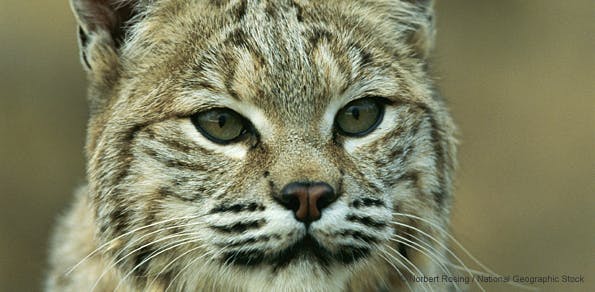Defenders of Wildlife has set itself the goal of moving more than 100 endangered species up the federal recovery ladder over the next decade. Our “Road to Recovery” series highlights several of these plants and animals and outline the challenges that lay ahead for improving their status.
Lynx’ Search for Salvation in the Distance
The Canada lynx, a secretive cat of the northern reaches of the United States, is a medium-sized member of the Felidae family. Lynx have beautiful grayish, spotted coats, short tails with a black tip, and ears with long fur tufts. But these cats are far from any house cat you might have encountered.

Lynx, © Alanna Schmidt / National Geographic Stock
Their unusually large paws function like snowshoes, adapted for hunting in the snow and giving them a beneficial advantage over other forest carnivores. Standing about two feet tall with long legs and weighing around 20 pounds, these felines appear to be larger than they really are. Lynx are specialized hunters that target snowshoe hares, which comprise the bulk of their diet, and can sustain populations only where there are adequate snowshoe hare populations. In fact, at northern latitudes, lynx populations fluctuate in response to hare abundance, though this is not as evident in the more southern reaches of their habitat in the lower 48 states, where hare numbers remain relatively low and stable.
Lynx can be found throughout much of the boreal forest of Alaska and Canada. The southern portion of their range has historically extended into the U.S. into the northern Rocky Mountains/Cascades, southern Rockies, Great Lakes states and the Northeast. Today, in the lower 48 states they are known to have breeding populations in Montana, Washington, Maine and Minnesota, and have been reintroduced to Colorado. They also have been spotted in Idaho, Vermont, New Hampshire,
Historically, lynx were valued so highly by trappers for their thick, soft fur that they were nearly eliminated in the lower 48 states. Their habitat was subsequently impacted by decades of timber management on federal lands without any guidance from federal agencies to conserve lynx (and snowshoe hare) habitat. In 2000, in response to Defenders’ petition and litigation, the U.S. Fish and Wildlife Service listed the lynx as “threatened” under the Endangered Species Act. Valuable conservation steps have been taken that require land management agencies to take lynx needs into account in management actions.
Defenders supported the Colorado Division of Wildlife as they reintroduced lynx to core habitat in the southern Rocky Mountains in 1999. More than 200 lynx were reintroduced into Colorado in the past decade. Today, this reintroduction effort has been deemed a success. At least 141 kittens have been born in Colorado, and we hope this population will continue to grow and thrive.

Canada lynx, ©Ken Curtis
Meanwhile, threats to lynx habitat have not gone away. Logging, road-building and high traffic volume, resource extraction such as oil drilling and mining, and winter recreation can disrupt, degrade and break up lynx habitat, or lead to direct mortality, making it harder for this species to survive. While ESA protection addresses some of these threats, individual projects may still occur that we deem harmful to the species and require our action. For example, in 2011, an oil company called PXP presented a proposal for 136 new oil and gas wells in lynx habitat in the Upper Hoback region of Wyoming, but the project was put on hold after we and our conservation colleagues intervened. After almost a year of waiting, we received the news we were waiting for. PXP agreed to sell its leases and end its project – a major victory! Defenders is continuing to monitor the lynx’s remaining strongholds in areas like the Hoback to ensure that the species’ needs are taken into account.
As a result of our and others’ continued pressure, critical habitat for lynx was first designated in 2006 and then greatly expanded in 2009. The USFWS recently released a proposal to revise lynx critical habitat, and Defenders’ team is currently working on analyzing and submitting our comments on that proposal to ensure that these changes help put lynx on the road to long-term recovery throughout its range.
John Yeingst is Defenders’ Communications Coordinator



